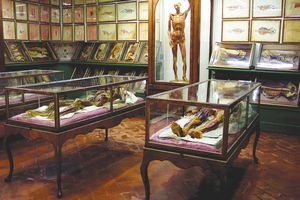La Specola
Via Romana 17
Entrance fee: 4 euro
Hours: 9–1, Sun – Tues; 9–5 Saturday
The ‘La Specola’ Museum opened to the public in 1775, under the auspices of the Grand Duke Pietro Leopoldo of Lorraine. It was originally called the Imperial Museum of Physics and Natural History. Like most of the city’s artistic heritage, the natural history collection first began under the Medici family, but it was not until the Hapsburg-Lorraine family came to power that it grew in number and gained importance. The building was commonly known as the la specola, or observatory, for the astronomical tower that was added in 1789 and remained there for almost a century. The ‘Tribuna di Galileo’ constructed between 1839 and 1841 was built in honor of the great scientist and is a rare example of late neoclassical architecture in Florence. It is decorated with carved marble, stucco and gold; the frescoes portray the life of Galileo and other important scientific discoveries.
The museum’s first director was the chemist and physiologist Abbot Felice Fontana from Rovereto, who considerably enlarged the collections, as well as the library, thanks to long expeditions abroad. He also organized the exhibitions and museum departments. The most important of these was the wax modelling workshop, which was in operation even before the museum opened. These models of human and comparative anatomy and botanical subjects are still admired today for their precision and artistic qualities. (The wax model collection will be highlighted in the next issue).
The exhibits cover an area of 1,200 sq. m., in 34 rooms, 10 of which are devoted to the anatomical waxes and 24 to zoology. The specimens are arranged systematically, and the wealth of the exhibits, especially some groups of animals, offers the visitor a rather complete picture of extant organisms as well as an appreciable number of extinct and endangered species.
Jane’s suggestion: A stuffed hippopotamus, a 17th-century Medici pet, which once lived in the Boboli Gardens, is in the collection.





